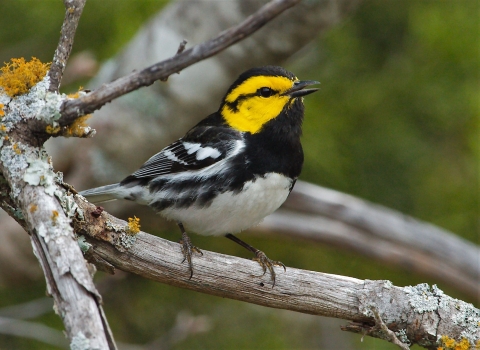The public can now review and comment on the U.S. Fish and Wildlife Service’s draft recovery plan for seven species listed as endangered or threatened under the Endangered Species Act found in the southern Edwards Aquifer springs and associated aquatic ecosystems. This recovery plan comprises a revised plan for four species and the first draft recovery plan for an additional three species, two beetles and an amphipod, that were listed in 1997. This plan applies only to federally protected species.
Public participation informs recovery plans and can help ensure they are effective and successful. A 60-day public comment period will close on Nov. 12, 2024.
The overall recovery strategy involves preserving, restoring, and managing species’ aquatic habitats, along with the water resources necessary to support healthy populations and the ecosystems on which they depend. The recovery strategy also includes using stock populations, or captive refugia, to protect against catastrophic events.
All the species are aquatic and depend on adequate groundwater and/or springflows in the southern segment of the Edwards Aquifer in Comal and Hays counties, Texas. The southern Edwards Aquifer is known for its high diversity of organisms and hosts the only known populations for some species included in the recovery plan.
The seven species addressed in the draft recovery plan include one plant, two beetles, one fish, one crustacean and two salamanders. They are the endangered Texas wild-rice, Comal Springs dryopid beetle, Comal Springs riffle beetle, fountain darter, Peck’s cave amphipod, Texas blind salamander and the threatened San Marcos salamander.
The primary threat to these species is a decrease in water quantity and quality because of water withdrawal and other human activities throughout the southern segment of the Edwards Aquifer. Climate change-driven aridity and warming temperatures exacerbates and accelerates these threats.
Successful recovery efforts will continue to involve cooperation and collaboration among Federal, State, and local agencies, private entities, and other stakeholders. The Edwards Aquifer Habitat Conservation Plan (EAHCP) helps protect endangered and threatened species and their critical habitat, the Edwards Aquifer, through the conservation of groundwater and restoration work.
“Current efforts by partners are underway to reduce non-native vegetation in the river and to ensure healthy aquatic ecosystems,” said Amy Lueders, the Service’s Southwest Regional Director. “By continuing to work collaboratively with local organizations, we make certain that the southern Edwards Aquifer springs and groundwater continue to provide clean freshwater that supports recovery. We all love the recreational opportunities provided by the Edwards Aquifer, and we all can benefit from this recovery plan.”
Maintaining the aquatic habitat will help prevent the extinctions of these seven species included in the draft recovery plan. Each of these species is found only in Central Texas and is uniquely adapted to their watery habitats. For instance, the aquatic subterranean species Texas blind salamander lives in the underground aquifer. This unusual creature has non-functioning eyes and little to no pigmentation.
“The Edwards Aquifer is a treasure,” said Amelia Hunter, Fish and Wildlife Biologist with the Service’s Southwest Regional Office. “It is something to protect and to explore through research. There are always new species being found.”
Spring flow is critically important for the survival of Texas wild-rice because it requires clear, relatively cool, thermally constant and flowing water. Texas wild-rice is found only within the San Marcos River in Central Texas, downstream from Spring Lake. Due to the presence of the upstream springs, this area of the river currently maintains a consistent temperature of 72 degrees Fahrenheit year-round. Warming waters due to climate change climate change
Climate change includes both global warming driven by human-induced emissions of greenhouse gases and the resulting large-scale shifts in weather patterns. Though there have been previous periods of climatic change, since the mid-20th century humans have had an unprecedented impact on Earth's climate system and caused change on a global scale.
Learn more about climate change can intensify threats to Texas wild-rice.
Because they are so sensitive to changes in water temperature and flow, these rare species act as early detection tools by providing warning signs about changes in water quality. Protecting the Edwards Aquifer is crucial not only to the survival of these species, but also to the human communities that depend on the groundwater.
As part of ongoing conservation efforts implemented by the EAHCP, the Service's San Marcos Aquatic Resources Center is contracted to house and to protect captive populations of 10 covered Edwards Aquifer species, including the seven species in this recovery plan, for re-introduction into the Comal or San Marcos systems in the event that a population is lost following a catastrophic event, such as a long-term drought or major flood. In addition, the refugia program conducts research activities to expand knowledge of the species’ habitat requirements, biology, life histories and effective reintroduction techniques. Additional populations of these species are also protected in the Service'sUvalde National Fish Hatchery in Uvalde, Texas.
Recovery plans are based on the best available science are crucial for coordinating efforts and resources toward conserving endangered or threatened species. While they are not regulatory, recovery plans provide a framework for species recovery with the goal that in the future, Endangered Species Act protections may no longer be necessary.
The Service encourages the public, federal and state agencies, Tribes, and other stakeholders to review the draft recovery plan and provide comments during the 60-day public comment period, ending on Nov. 12, 2024. The draft recovery for the seven Edwards Aquifer listed species can be found online at ecos.fws.gov. To submit a comment, email the Austin Ecological Services Field Office at esaustininfo@fws.gov.
America’s fish, wildlife and plant resources belong to all of us, and ensuring the health of imperiled species is a shared responsibility. The Service actively engages conservation partners and the public in the search for improved and innovative ways to conserve and recover imperiled species.




